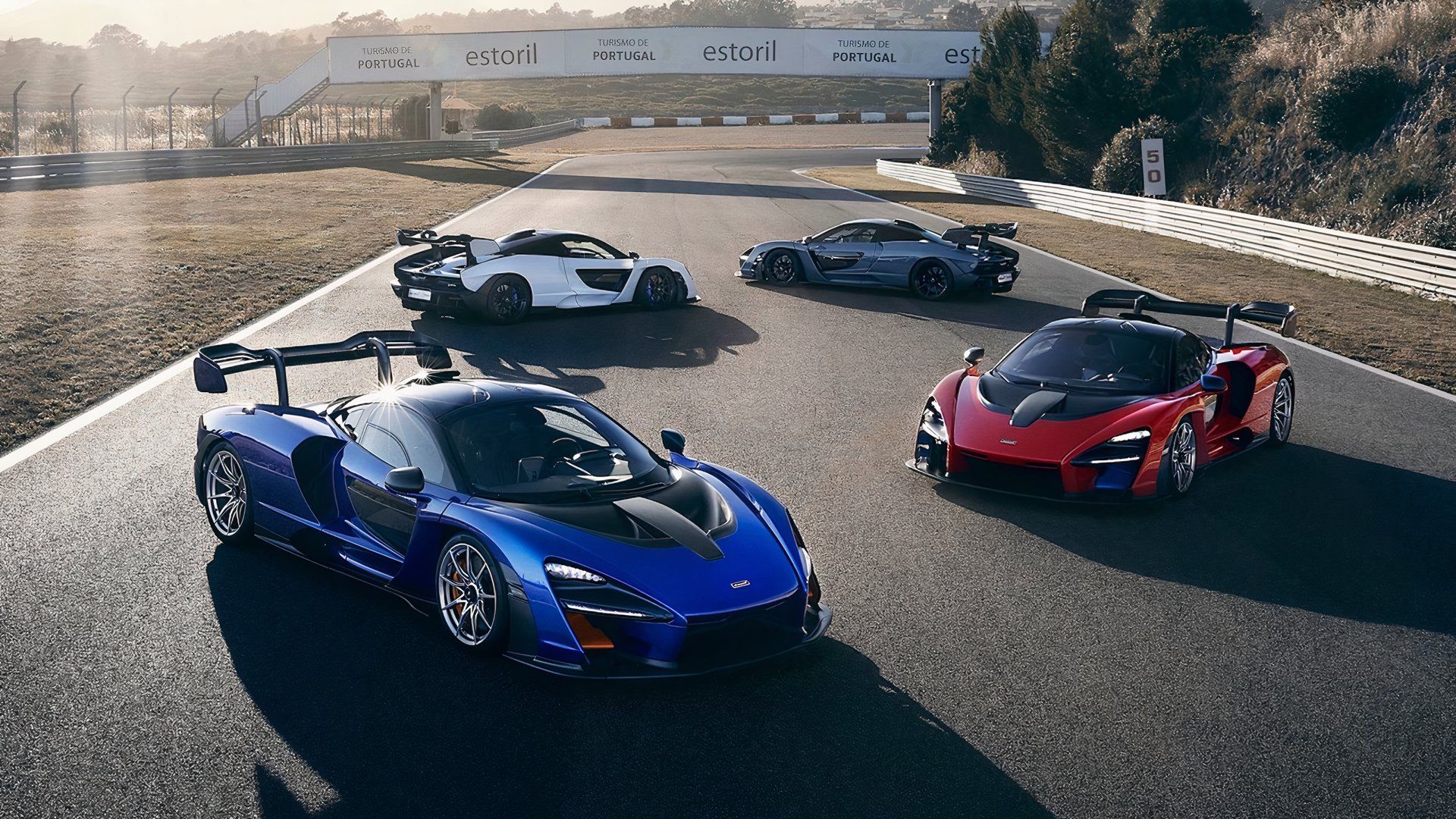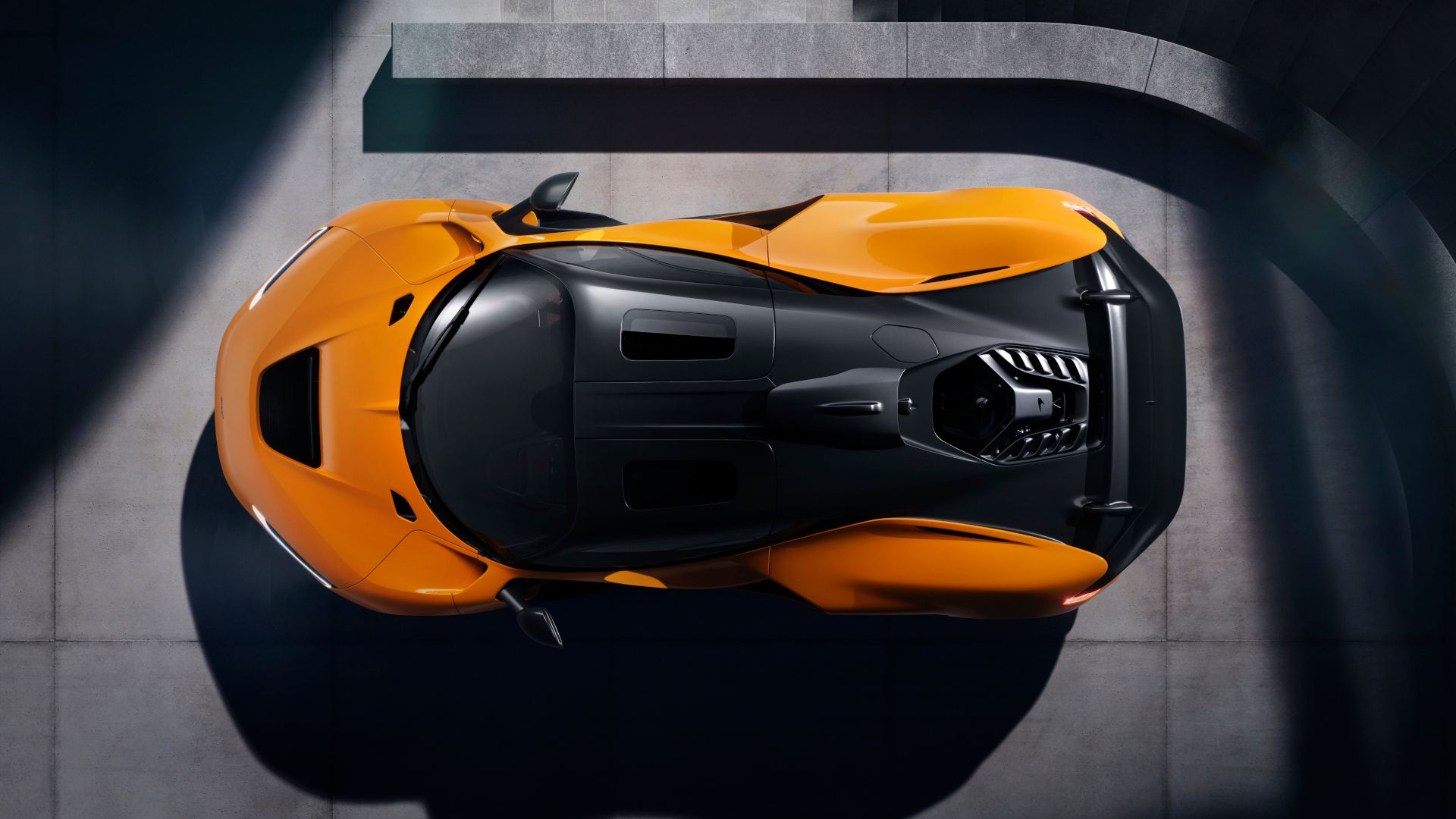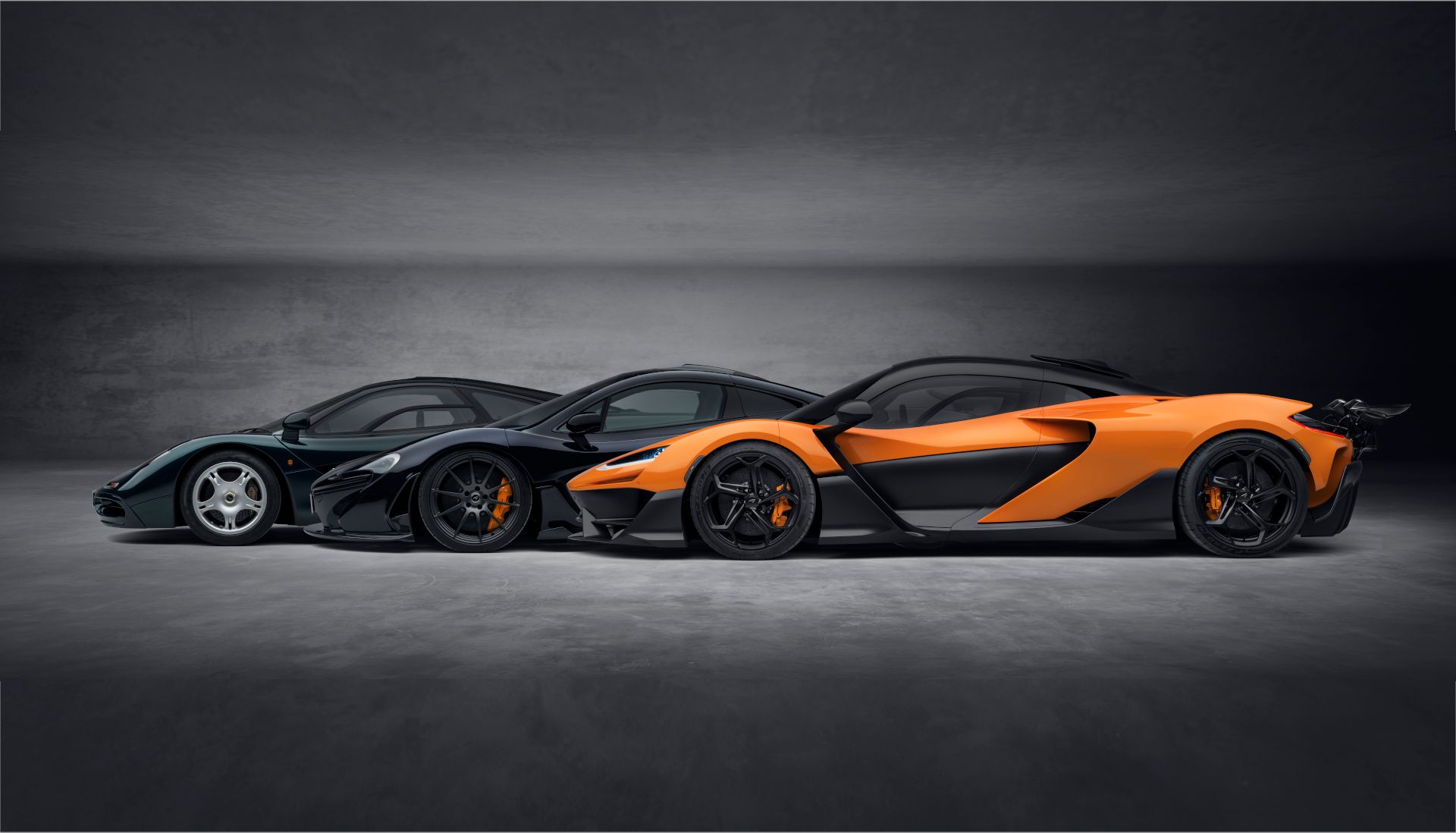McLaren has a unique obligation with its bloodline of cars bearing the number 1. The McLaren F1 set a new standard for driving pleasure and outright performance when it arrived in 1992, and its astonishing racing iterations blew the competition away on the track. In 2013, the McLaren P1 stood out as arguably the most performance-focused and extreme of the hypercar Holy Trinity, creating something for a whole new generation of performance enthusiasts to lust after. And in 2024, the McLaren W1 celebrates the Woking-based manufacturer’s “World Championship mindset,” with today marking the 50th anniversary of Emerson Fittipaldi securing McLaren’s first-ever Formula 1 Drivers’ and Constructors’ World Championships.
In a world saturated with supercars, it’s easy to be cynical about such a statement, but as we’re about to see, the W1 embraces heritage and innovation in equal measure, paying tribute to the F1 and the M6A Can-Am ground effect race car (the first Mac to use the Papaya livery), the P1 and the MCL38 ground effect F1 car. As we’re about to explore, the W1 represents a holistic approach to what it means to be a supercar, taking into account comfort and practicality without ever losing sight of the fact that this needs to foreshadow the next decade of McLaren super sports cars as the Ultimate Series halo.
Powertrain And Weight
Performance Details At A Glance
- 4.0-liter MHP-8 V8 engine and e-module with 1,258 horsepower/988 lb-ft of torque
- Eight-speed dual-clutch automatic on rear-axle
- RWD only
- 1.6-mile electric range from 1.384 kWh battery
- 3,084-lb dry weight
- 2,205 lbs of downforce
Just like the P1, the W1 has found a way to use the idea of electrification almost exclusively for the purposes of performance. In fact, the entire 342-hp hybrid system (which has the same energy density as Formula 1 e-motors) weighs 88.2 lbs less than that in the P1 while delivering almost double the power. This is mated to a new Ricardo-developed engine, which boasts hollow valves with finger followers coated in a Diamond Like Coating, as well as aluminum pistons. These lightweight components help achieve a redline of 9,200 rpm from the 916-hp engine. Plasma-coated cylinder bores below the aluminum heads help to deal with the extreme temperatures necessary in creating a supercar with an astonishing 899 horsepower per tonne, the highest of any road-legal McLaren to date and the best in its class.

Fun Fact
The flat-plane 3,988cc MHP-8 engine’s output of 916 hp is 102 hp higher than that of the most extreme version of the outgoing M840T engine in the Senna GTR. Despite this, it’s marginally lighter and some 2.2 inches shorter. The W1’s powertrain is also angled at three degrees to enable the F1-style T-tray and keel to feed a large rear diffuser, helping increase maximum downforce by nearly 443 lbs over the regular Senna and matching that of the track-only GTR model.
This brings us to the weight, which is quoted at 3,084 lbs (dry). This is made possible by the new McLaren Aerocell monocoque, whose design must have taken more meetings than the designers would probably like to admit. That’s because it enables F1-derived suspension, improves occupant ingress, wraps closely around the engine without melting, maximizes aerodynamic potential, and through all of this, enables the retention of both hydraulic braking and hydraulic steering systems. I swear, it nearly brought a tear to my eye reading that last bit in the press release. This is a hypercar designed by enthusiasts, for enthusiasts (and yes, rich collectors – regardless, all allocations have already been rightfully snatched up).
Top Speed, Acceleration & Deceleration
|
0-60 mph |
2.7 seconds |
|
0-124 mph |
5.8 seconds |
|
0-186 mph |
|
|
62-0 mph |
95 feet |
|
124-0 mph |
328 feet |
|
Top Speed |
217 mph |
The McLaren Carbon Ceramic Racing+ brakes include six-piston calipers in front and four-piston calipers (with an electronic parking brake) at the rear, with 15.4-inch discs that boast an additional layer of ceramic that enables a more aggressive pad and better thermal management. These are cooled by F1-style brake ducts, and these contribute to downforce. The brake lines are kept away from the airflow, and the lower wishbones of the front pushrod suspension and its inboard dampers (featuring titanium torsion bars and an active heave crosslink) are raised to enable the F1-style keel. In addition, a more central steering rack position nearer the center of the wheels allows two ride height settings without negatively impacting geometry. At the rear, outboard springs and dampers feature a Z-bar with active droplinks for heave control.
Aerodynamics And Styling
A key feature is the Active Long Tail, which extends by up to 11.6 inches rearward, creating up to five times more downforce than in its road setting. This all-encompassing approach to supercar design – from the suspension and weight distribution to the monocoque shape and the ground effects aerodynamic package of the car – helps retain a rear-wheel-driven setup when so many are opting for AWD to keep inexperienced drivers out of hedges and barriers. As standard, you get Pirelli P Zero Trofeo RS rubber measuring 265/35 over 19×9.5-inch wheels in the front and 335/30 over 20×12-inch wheels at the rear, with less aggressive P Zero R and P Zero Winter 2 rubber also offered.
The specially designed model-specific rubber can handle the car’s peak downforce figure of up to 2,205 lbs (772 at the front and 1,433 lbs at the rear), allowing the W1 to lap the Nardo circuit some three seconds quicker than the Senna, despite simultaneously allowing it to get to 186 mph quicker than the incredibly slippery Speedtail when the DRS function is enabled. This mode reduces downforce on the W1 to 20% less than the Senna, but the rear wing is not the only active aero element. At the front, a pair of front wings swing in an arc to send air under the car but retract at low speeds. This prevents damage, as does a vehicle lift.
“The McLaren W1 is the perfect execution of a bold and ambitious aerodynamic philosophy that delivers impressive lap times through not only high downforce but optimal aerodynamic behavior and active control. The all-integral aerodynamic platform with the Aerocell as the centerpiece enables fully underbody ground effect in Race mode. Inherently efficient, W1 deploys staggering levels of downfocre for relatively little drag. Thanks to numerous innovations, we have succeeded in incorporating elegantly F1-inspired vortical flow fields to an uncompromised road car.”
– Robin Algoo, Principal Aerodynamics Engineer, McLaren Automotive and former Formula 1 aerodynamicist
Conversely, in Race mode, the car drops by 1.46 inches at the front and 0.7 inches at the rear. On the sides, a pair of aero blades behind the front wheels keep downforce high at all times, with the effect increasing as the wheel angle increases. This leads to what looks like an F1 sidepod that is actually the new McLaren Anhedral door, which saves cooling area and also helps increase foot space for ingress. We could go on for ages about how this nearly entirely carbon fiber body has been shaped, but we see elements of both F1 and 750S in the frontal fascia, headlights and glasshouse, and we see both P1 and Senna in the rear quarters, as well as hints of the Can-Am racer. The overall effect moves the needle while still paying tribute to the past, and at the same time, this is still clearly a McLaren from any angle, a neat trick of self-awareness that few automakers can pull off without awkwardness.
Interior, Customization, And Pricing
Like any self-respecting hypercar, the seats are simply molded to the chassis, and the aluminum pedals and squared steering wheel move to greet you, with the former angled upward like in a race car and the latter aerodynamically shaped to help distribute conditioned air to the driver. The steering wheel is particularly noteworthy, as it’s more yoke-shaped than most Macs but is promised to offer an unobstructed view of the cluster. More importantly, McLaren has added buttons for the first time, but in true driver-focused style, only two exist in reach of the thumbs, and they’re for the DRS function and a Boost feature, which deploys stored energy. Speaking of, a GP mode offers sustained output over long sessions while Sprint mode delivers all-out performance for a single lap.

Fun Fact
The 24,000-rpm electric motor between the eight-speed DCT and the engine handles reverse and removes the need for an alternator, a starter motor, and the pipework needed for a conventional HVAC system. The battery maintains enough power to start the car when parked for extended periods, but it can be fully recharged in 22 minutes using a home charger.
The central eight-inch touchscreen gets Apple CarPlay and a pair of USB ports, and below this, a sliding dual cupholder console leads backward toward a 4.1 cubic-foot storage compartment that can be accessed by moving the headrests. This has enough space for a pair of weekend bags or a pair of helmets. Another highlight, although leather and Alcantara are available, is the InnoKnit material, which reduces waste by being knitted to size rather than sewn and trimmed. Additional carbon fiber highlights in a glossy finish are optional, as are shift lights in the steering wheel, and an essentially limitless number of MSO finishes for the exterior. Just 399 units will be made, each starting at $2.1 million, which, these days – and for something of this gravitas and excellence – seems almost like a bargain.

Expert Opinion
McLaren has created a highly innovative hypercar that is worthy of sharing part of its nomenclature with its iconic predecessors, bringing patent-pending tech to the real world. A new Intermediate Modulus Carbon Fiber material can handle the heat of the powertrain, allowing the chassis to be “shrinkwrapped” around it like a Formula 1 car. The suspension and overall aero package enable a pure RWD setup, as well as feelsome steering and an engaging brake pedal. The looks are worthy of a place on any kid’s smartphone wallpaper, yet they also stir emotions in those who idolized the F1 and stood awestruck at the P1. Those same looks simultaneously capture the drama and excitement of Formula One thanks to convex doors and an Active Long Tail. This nod to the top tier of racing doesn’t feel forced, and the W1’s numbers amaze, even in a world of EV power. In a nutshell, the W1 beautifully captures the story of McLaren, including its 16 World Championship titles in the ultimate form of motorsport, its poster-worthy road cars, and its trajectory for the future on and off the track. With the potential for another two F1 titles this year, McLaren is ready to stand at the pinnacle of performance once again, and the W1 could be the ultimate celebration of that pursuit of perfection.












